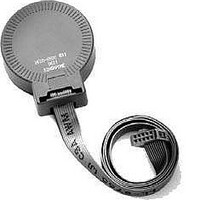HEDM-6500#T06 Avago Technologies US Inc., HEDM-6500#T06 Datasheet - Page 4

HEDM-6500#T06
Manufacturer Part Number
HEDM-6500#T06
Description
Encoders 2 Channel 2000CPR
Manufacturer
Avago Technologies US Inc.
Type
Optical Encoderr
Datasheet
1.HEDM-6500T06.pdf
(14 pages)
Specifications of HEDM-6500#T06
Number Of Channels
2
Supply Voltage
5 V
Operating Temperature Range
- 40 C to + 100 C
Product
Optical
Size / Dimension
56 mm
Pulses Per Revolution
2000 CPR
Detents
No
Motion
Rotary
Mounting Style
Screw
Index Output
Not Indexed
Encoder Signal
Digital
Built In Switch
No
Shaft Style
Round
Shaft Diameter (mm)
6.35mm
Operating Temperature Min Deg. C
-40C
Operating Temperature Max Deg. C
70C
Terminal Type
Cable
Lead Free Status / RoHS Status
Lead free / RoHS Compliant
Theory of Operation
The HEDS-65xx / HEDL-65xx translate the rotary motion
of a shaft into either a two or three channel digital
output.
The HEDS-65xx uses one of the standard HEDS-9000
or HEDS-9040 modules for encoding purposes. The
HEDL-654x uses the standard HEDL-9040 for encoding
purposes.
As seen in the block diagram, these modules contain a
single Light Emitting Diode (LED) as their light source
(emitter). The light is collimated into a single parallel
beam by means of a plastic lens located directly over
the LED. Opposite the emitter is the integrated detector
circuit (detector). This circuit consists of multiple sets
of photodetectors and the signal processing circuitry
necessary to produce the digital waveforms.
The codewheel rotates between the emitter and
detector, causing the light beam to be interrupted by a
pattern of spaces and bars on the codewheel. The pho-
todiodes which detect these interruptions are arranged
in a pattern that corresponds to the radius and design
of the codewheel. These detectors are also spaced such
that a light period on one pair of detectors corresponds
to a dark period on the adjacent pair of detectors. The
photodiode outputs are then fed into the signal pro-
cessing circuitry resulting in A,
the three channel encoders). Comparators receive these
signals and produce the final outputs for channels A and
B. Due to this integrated phasing technique, the digital
output of channel A is in quadrature with that of channel
B (90 degrees out of phase).
In the HEDS-6540 / HEDL-6540 the output of the com-
parator for the index pulse is combined with that of the
outputs of channel A and channel B to produce the final
index pulse. The index pulse is generated once every
rotation of the codewheel and is a one state width
(nominally 90 electrical degrees), true high index pulse.
It is coincident with the low states on channels A and B.
4
–
A, B, and B (I and
–
I also in
Definitions
Count (N): The number of bar and window pairs or counts
per revolution (CPR) of the codewheel.
One Cycle (C): 360 electrical degrees (e), 1 bar and
window pair.
One Shaft Rotation: 360 mechanical degrees, N cycles.
Position Error (∆Θ): The normalized angular difference
between the actual shaft position and the position
indicated by the encoder cycle count.
Cycle Error (∆C): An indication of cycle uniformity. The
difference between an observed shaft angle which gives
rise to one electrical cycle, and the nominal angular
increment of 1/N of a revolution.
Pulse Width (P): The number of electrical degrees that an
output is high during one cycle. This value is nominally
180 e or 1/2 cycle.
Pulse Width Error (∆P): The deviation, in electrical degrees,
of the pulse width from its ideal value of 180 e.
State Width (S):
between a transition in the output of channel A and the
neighboring transition in the output of channel B. There
are 4 states per cycle, each nominally 90 e.
State Width Error (∆S): the deviation, in electrical degrees,
of each state width from its ideal value of 90 e.
Phase (Φ): the number of electrical degrees between the
center of high state on channel A and the center of the
high state on channel B. This value is nominally 90 e for
quadrature output.
Phase Error (∆Φ): The deviation of the phase from its
ideal value of 90 e.
Direction of Rotation: When the codewheel rotates in
a counterclockwise direction (when viewed from the
encoder end of the motor) channel A will lead channel B.
If the codewheel rotates in the clockwise direction
channel B will lead channel A.
Index Pulse Width (P0): The number of electrical degrees
that an index output is high during one full shaft rotation.
This value is nominally 90 e or 1/4 cycle.
The number of electrical degrees

















